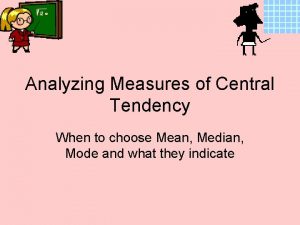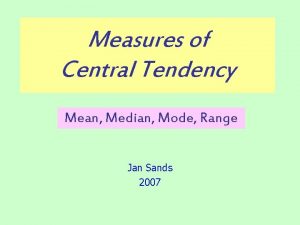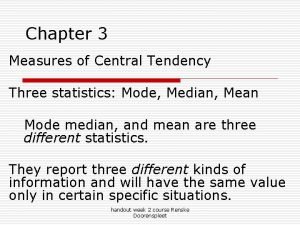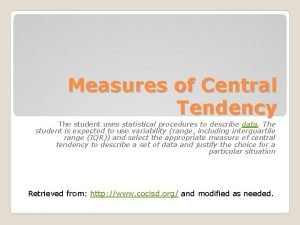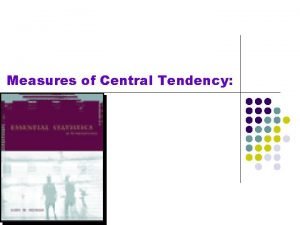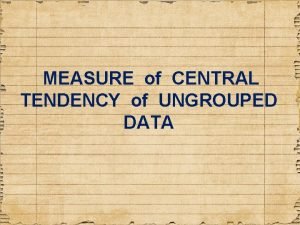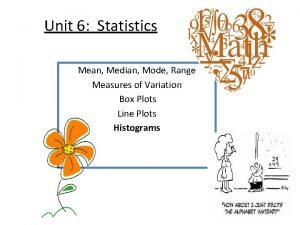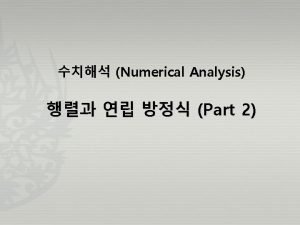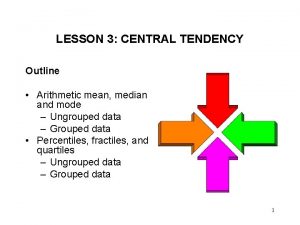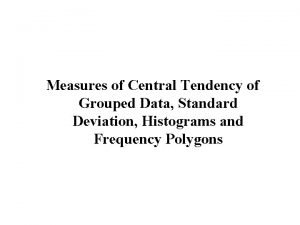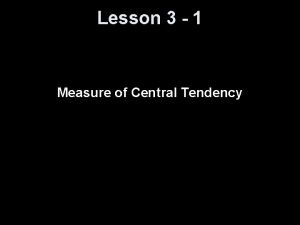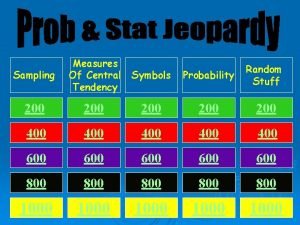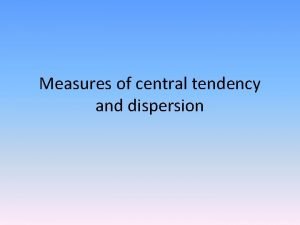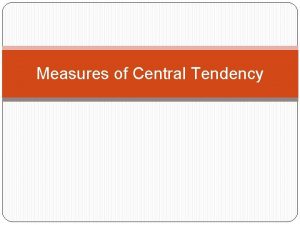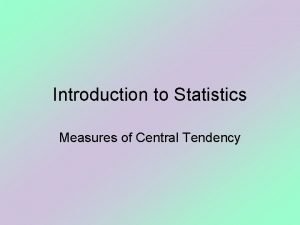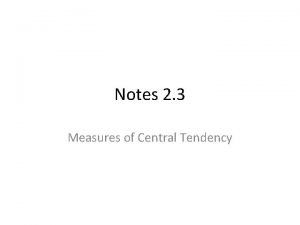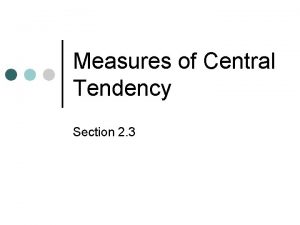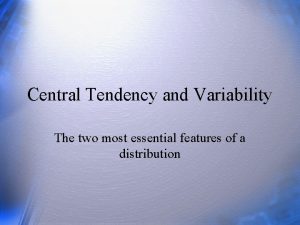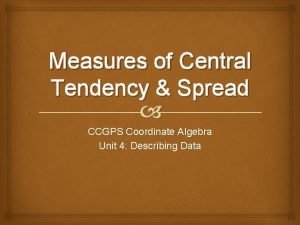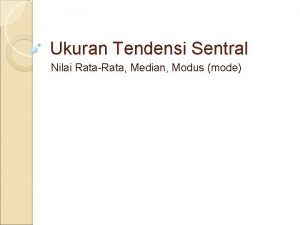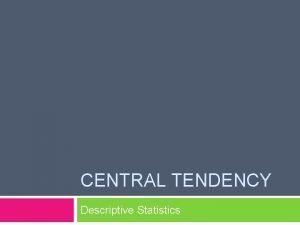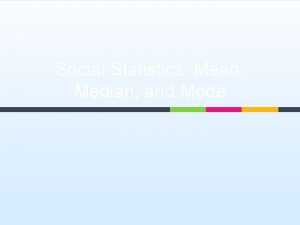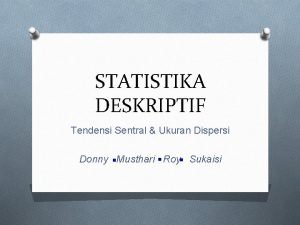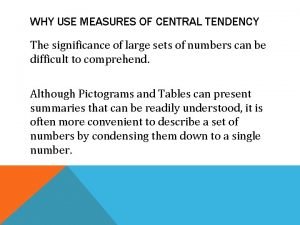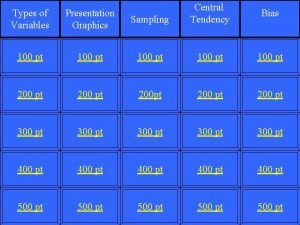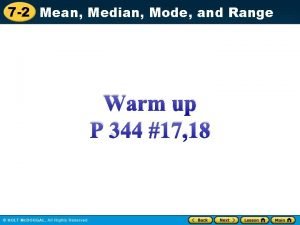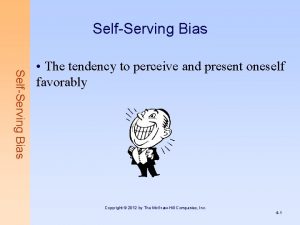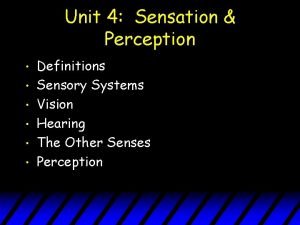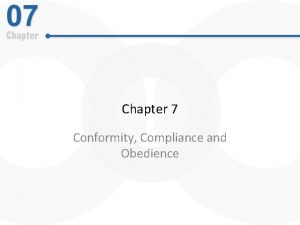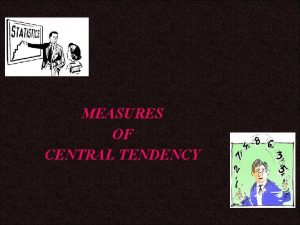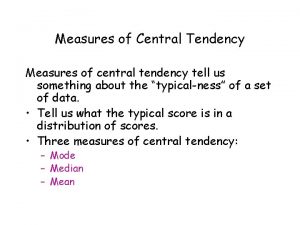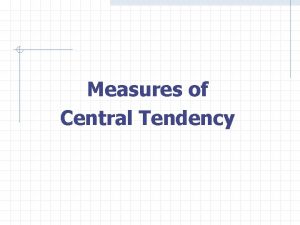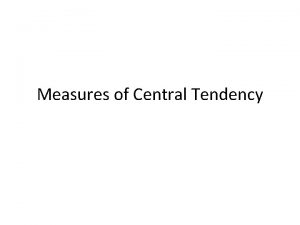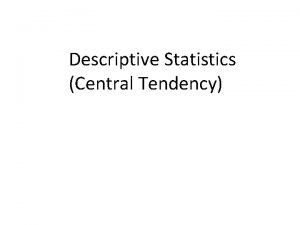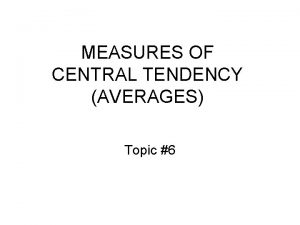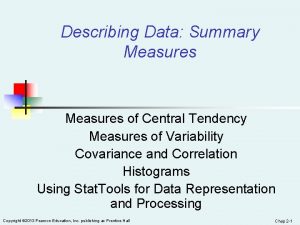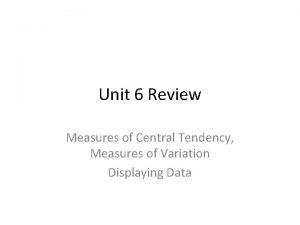Measures of Central Tendency Measures of Central Tendency


















































- Slides: 50

Measures of Central Tendency

Measures of Central Tendency

Measures of Central Tendency Measure of central tendency provides a very convenient way of describing a set of scores with a single number that describes the PERFORMANCE of the group.

Measures of Central Tendency It is also defined as a single value that is used to describe the “center” of the data.

Measures of Central Tendency There are three commonly used measures of central tendency. These are the following: Mean Median Mode

Mean It is the most commonly used measure of the center of data.

Mean It is also referred as the “arithmetic average”

Mean Computation of Sample Mean _ X = Σ x = x 1 + x + … x N N 2 3 n

Mean Computation of the Mean for Ungrouped Data _ _ X = Σx X = Σfx n n

Mean Example: Scores of 15 students in Mathematics I quiz consist of 25 items. The highest score is 25 and the lowest score is 10. Here are the scores: 25, 20, 18, 17, 15, 15, 14, 13, 12, 10. Find the mean in the following scores.

Mean x (scores) 25 14 20 14 18 13 18 12 17 12 15 10 15 _ X = Σx n = 228 15 = 15. 2

Mean _ X = 15. 2 Analysis: The average performance of 15 students who participated in mathematics quiz consisting of 25 items is 15. 20. The implication of this is that student who got scores below 15. 2 did not perform well in the said examination. Students who got scores higher than 15. 2 performed well in the examination compared to the performance of the whole class.

Example: Find the Grade Point Average (GPA) of Paolo Adade for the first semester of the school year 2013 -2014. Use the table below: Subjects Grade (Xi) Units (wi) (Xi) (wi) BM 112 1. 25 3 3. 75 BM 101 1. 00 3 3. 00 AC 103 1. 25 6 7. 50 EC 111 1. 00 3 3. 00 MG 101 1. 50 3 4. 50 MK 101 1. 25 3 3. 75 FM 111 1. 50 3 4. 50 PE 2 1. 00 2 2. 00 Σ(wi) = 26 Σ(Xi)wi)=32. 00

Mean _ X = Σ(Xi)wi) Σ(wi) = 32 26 = 1. 23 The Grade Point Average of Albie Sigal for the first semester SY 2016 -2017 Is 1. 23.

Mean for Group Data Grouped data are the data or scores that are arranged in a frequency distribution. n Frequency distribution is the arrangement of scores according to category of classes including the frequency. n Frequency is the number of observations falling in a category.

Mean The only one formula in solving the mean for grouped data is called midpoint method.

Mean The formula is: _ X = Σfx _ n Where X = mean value xm = midpoint of each class or category f = frequency in each class or category Σ f xm = summation of the product of f xm

Mean Steps in Solving Mean for Grouped Data 1. Find the midpoint or class mark (Xm) of each class or category using the formula Xm = LL + LU. 2. Multiply the frequency and the corresponding class mark f xm.

Mean Steps in Solving Mean for Grouped Data 3. Find the sum of the results in step 2. 4. Solve the mean using the formula. _ X = Σfx n

Example: Scores of 40 students in a science class consist of 60 items and they are tabulated below. _ Xc f Xm f. Xm 10 – 14 5 12 60 15 – 19 2 17 34 20 – 24 3 22 66 25 – 29 5 27 135 30 – 34 2 32 64 35 – 39 9 37 333 40 – 44 6 42 252 45 – 49 3 47 141 50 - 54 5 52 260 n = 40 Σ f Xm = 1 345 X = Σ f xm n = 1 345 40 = 33. 63

Mean Analysis: The mean performance of 40 students in science quiz is 33. 63. Those students who got scores below 33. 63 did not perform well in the said examination while those students who got scores above 33. 63 performed well.

Mean Properties of the Mean It measures stability. Mean is the most stable among other measures of central tendency because every score contributes to the value of the mean. The sum of each score’s distance from the mean is zero. It may easily affected by the extreme scores.

Mean Properties of the Mean It can be applied to interval level of measurement. It may not be an actual score in the distribution. It is very easy to compute.

Mean When to Use the Mean Sampling stability is desired. Other measures are to be computed such as standard deviation, coefficient of variation and skewness. Median is what divides the scores in the distribution into two equal parts.

Mean When to Use the Mean Fifty percent (50%) lies below the median value and 50% lies above the median value. It is also known as the middle score or the 50 th percentile.

Median of Ungrouped Data 1. Arrange the scores (from lowest to highest or highest to lowest). 2. Determine the middle most score in a distribution if n is an odd number and get the average of the two middle most scores if n is an even number.

Median of Ungrouped Data Example 1: Find the median score of 7 students in an English class. x (score) 19 17 16 15 10 5 2

Median of Ungrouped Data Example: Find the median score of 8 students in an English class. x (score) 30 x = 16 + 19 15 17 2 16 x = 15. 5 15 10 5 2

Median of Grouped Data Formula: n_ x = LB + _2 fm cfp_ X c. i

Median of Grouped Data Where; X = median value _n_ MC = median class is a category containing the 2 LB = lower boundary of the median class (MC) cfp = cumulative frequency before the median class if the scores are arranged from lowest to highest value fm = frequency of the median class c. i = size of the class interval

Median Steps in Solving Median for Grouped Data 1. Complete the table for cf<. _n_ 2. Get 2 of the scores in the distribution so that you can identify MC.

Median Steps in Solving Median for Grouped Data 3. Determine LB, cfp, fm, and c. i. 4. Solve the median using the formula.

Example: Scores of 40 students in a science class consist of 60 items and they are tabulated below. The highest score is 54 and the lowest score is 10. X f cf< 10 – 14 5 5 15 – 19 2 7 20 – 24 3 10 25 – 29 5 15 30 – 34 2 17 (cfp) 35 – 39 9 (fm) 26 40 – 44 6 32 45 – 49 3 35 50 – 54 5 40 n = 40

Median Solution: _n_ _40_ 2 = 20 _n_ The category containing 2 LL of the MC = 35 Ln = 34. 5 cfp = 17 fm = 9 c. i = 5 is 35 – 39.

Median Solution: _n_ x = LB + _2 cfp_ X c. i fm _20 – 17_ X 5 = 34. 5 + 9 = 34. 5 + 15/9 x = 36. 17

Median Properties of the Median It may not be an actual observation in the data set. It can be applied in ordinal level. It is not affected by extreme values because median is a positional measure.

Median When to Use the Median The exact midpoint of the score distribution is desired. There are extreme scores in the distribution.

Mode The mode or the modal score is a score or scores that occurred most in the distribution.

Mode It is classified as unimodal, bimodal, trimodal or mulitimodal. Unimodal is a distribution of scores that consists of only one mode. Bimodal is a distribution of scores that consists of two modes. Trimodal is a distribution of scores that consists of three modes or multimodal is a distribution of scores that consists of more than two modes.

Mode Example: Scores of 10 students in Section A, Section B and Section C. Scores of Section A Scores of Section B Scores of Section C 25 25 25 24 24 25 20 20 22 20 18 21 16 17 21 12 10 18 10 9 18 7 7 18

Mode The score that appeared most in Section A is 20, hence, the mode of Section A is 20. There is only one mode, therefore, score distribution is called unimodal. The modes of Section B are 18 and 24, since both 18 and 24 appeared twice. There are two modes in Section B, hence, the distribution is a bimodal distribution. The modes for Section C are 18, 21, and 25. There are three modes for Section C, therefore, it is called a trimodal or multimodal distribution.

Mode for Grouped Data In solving the mode value in grouped data, use the formula: ___d 1___ X = LB + d 1 + d 2 x c. i

Mode for Grouped Data LB = lower boundary of the modal class Modal Class (MC) = is a category containing the highest frequency d 1 = difference between the frequency of the modal class and the frequency above it, when the scores are arranged from lowest to highest. d 2 = difference between the frequency of the modal class and the frequency below it, when the scores are arranged from lowest to highest. c. i = size of the class interval

Mode for Grouped Data Example: Scores of 40 students in a science class consist of 60 items and they are tabulated below. x f 10 – 14 5 15 – 19 2 20 – 24 3 25 – 29 5 30 – 34 2 35 – 39 9 40 – 44 6 45 – 49 3 50 – 54 5 n = 40

Mode for Grouped Data Modal Class = 35 – 39 LL of MC = 35 LB = 34. 5 d 1 = 9 – 2 = 7 d 2 = 9 – 6 = 3 c. i = 5

Mode for Grouped Data ___d 1___ X = LB + d 1 + d 2 ___7___ = 34. 5 + 7 + 3 x = 34. 5 + 35/10 X = 38 x c. i 5 The mode of the score distribution that consists of 40 students is 38, because 38 occurred several times.

Mode Properties of the Mode It can be used when the data are qualitative as well as quantitative. It may not be unique. t is affected by extreme values. It may not exist.

Mode When to Use the Mode When the “typical” value is desired. When the data set is measured on a nominal scale.

Software Application: Excel SPSS

 Measures of central tendency worksheet
Measures of central tendency worksheet Range in central tendency
Range in central tendency Statistics chapter 3 measures of central tendency
Statistics chapter 3 measures of central tendency Measures of central tendency and variation
Measures of central tendency and variation Interquartile range in grouped data
Interquartile range in grouped data In quartiles central tendency median is
In quartiles central tendency median is Measures of central tendency
Measures of central tendency Central tendency
Central tendency Central tendency symbols
Central tendency symbols Unit 6 review #2 - measures of central tendency
Unit 6 review #2 - measures of central tendency Nxn 역행렬 알고리즘
Nxn 역행렬 알고리즘 Mean ka formula
Mean ka formula Central tendency grouped data
Central tendency grouped data Mean median mode grouped data exercises
Mean median mode grouped data exercises Measures of central tendency
Measures of central tendency Measures of central tendency symbols
Measures of central tendency symbols Central tendency and dispersion
Central tendency and dispersion Objectives of measures of central tendency
Objectives of measures of central tendency Central tendency symbols
Central tendency symbols Measures of central tendency
Measures of central tendency Measures of central tendency notes
Measures of central tendency notes Central tendency symbols
Central tendency symbols Variance meaning
Variance meaning Central tendency and spread homework
Central tendency and spread homework Summation notation
Summation notation Tendensi sentral adalah
Tendensi sentral adalah Central tendencies statistics
Central tendencies statistics Use of central tendency
Use of central tendency Median for even numbers
Median for even numbers Is range part of central tendency
Is range part of central tendency Importance of central tendency
Importance of central tendency Objective of central tendency
Objective of central tendency Central tendency
Central tendency Table 1 shows the distribution of scores among students
Table 1 shows the distribution of scores among students Fraktil
Fraktil Median data
Median data Central tendancy bias
Central tendancy bias Central tendency spss
Central tendency spss Finding median
Finding median Central tendency symbols
Central tendency symbols Repeated measures design
Repeated measures design Selfserving bias
Selfserving bias Flightscope aviation
Flightscope aviation The actualising tendency
The actualising tendency The perceptual tendency to group together stimuli
The perceptual tendency to group together stimuli The societal tendency toward class stratification
The societal tendency toward class stratification Projected cognitive similarity is the tendency to
Projected cognitive similarity is the tendency to Qg height tendency equation
Qg height tendency equation Distingushe
Distingushe Tendency to conform
Tendency to conform What is the conflict in animal farm
What is the conflict in animal farm
